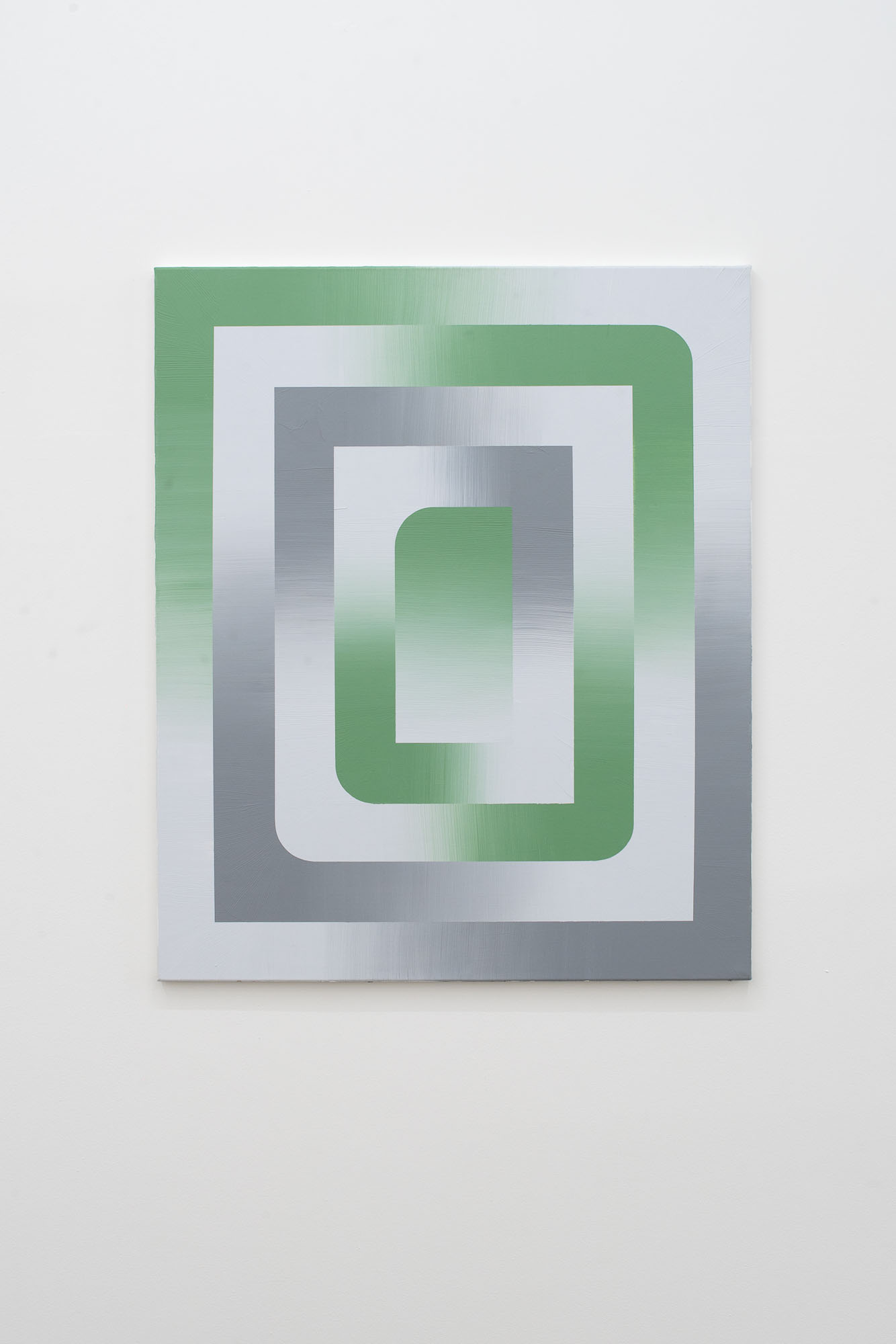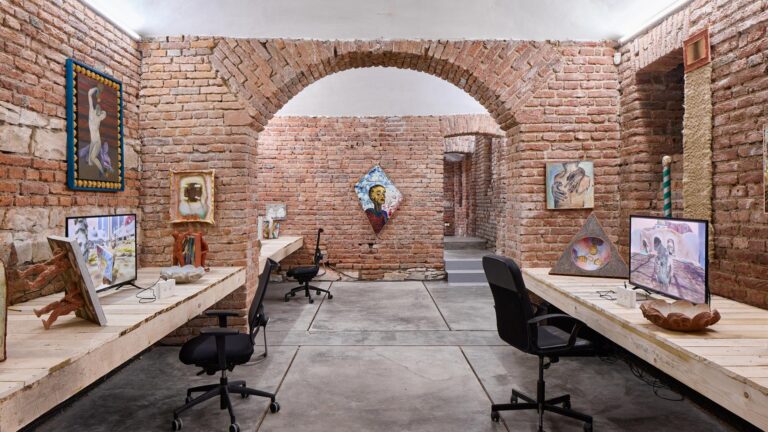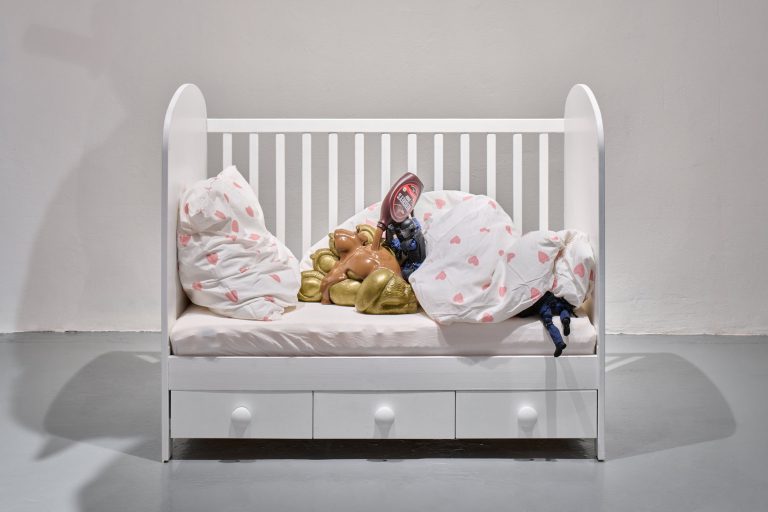Artist: Agata Bogacka
Exhibition title: The law of balance
Venue: SVIT, Prague, The Czech Republic
Date: May 28 – July 13, 2019
Photography: all images copyright and courtesy of the artist and SVIT, Prague
Agata Bogacka keeps working on a painting until she gets it right. Each artwork involves a long and toilsome process. The artist never concludes with the original idea; instead, she continues to work until she is genuinely pleased with the effect, until she feels there is nothing more to add. Only then she considers the painting a finished work of art.
Point of departure for Agata’s most recent abstract compositions is a meeting of different surfaces. The paintings consist in a sharp contrast of edges at times or in a subtle blur at other times; in a full control of the working process, or in leaving it to chance at other moment. Most of her artworks are hard on the eye; they play tricks on the viewer just like the best examples of op-art. Agata employs similar effects in a subtle way, thus encouraging the viewer to take another look.
This sort of dissonance attracts people to Agata’s artworks. The paintings may mislead the viewer at first, but the longer one looks at them the more one becomes aware of inconsistencies. The paintings reveal more and more layers and more intriguing details. Even if a painting offers a suggestion of representation or a painterly illusion, the artist draws our attention to the very surface of the canvas—she reminds us that, above all else, we are dealing with a canvas.
At first glance, the paintings may seem complete. However, the artist deliberately interferes with them, introduces shifts and disruptions, and disturbs their rhythm. Her compositions always bear “imperfections”, produced randomly or because of disregard—entire sections of the canvas may remain untouched.
Agata deliberately leaves traces of former layers, of failed attempts and mistakes on the canvas. When she talks about her paintings, she even refers to the Italian term pentimento, typically used in reference to old paintings. It means precisely the traces of fragments that have been painted over, either on purpose or by accident, often resurfacing long time after the painting was finished. Agata employs this effect with intent; every inch of her canvases is well-thought-out.
These seeming errors or marks of all the stages in the process of producing a painting introduce an unrest of sorts to Agata’s works. Each painting is akin to a palimpsest. One discerns thicker layers of paint in many places, marks left by the brush, or small fragments of former layers. Her artworks implore to be scrutinized. In the case of Head in the Clouds 5 it appears that the artist decided to shift the central motif towards the upper edge of the canvas; its former location continues to loom in the middle, as an after-image of sorts.
The quintessence of Agata Bogacka’s art is the painting process itself, rather than the end result. Therefore, we may safely say that her abstract paintings reflect the complex and disciplined thought process.
At the SVIT gallery, Agata presents artworks produced in the course of the past few months. She continues the cycles that she has recently begun, displayed last winter as part of her breakthrough solo exhibition at the Pola Magnetyczne gallery in Warsaw.
Agata likes to revert to the threads she has followed before, as if she were eager to find out where the painting process may lead her this time. Each painting is a task to be solved. In the cycle titled Views she starts with dividing the surface of the canvas according to the rule of linear perspective which she then distorts and transforms. In the case of View 6 presented at the exhibition, there is a barely visible trace of the original composition. Thus, the painting acquires a unique depth, a suggestion of many layers stretching in front of the viewer, as if in a theatrical mis-en-scene.
The new cycle titled Promises, presented in Prague for the first time, is based on the radiuses running from the central spot on the canvas, and on a certain blur (outside the composition in case of Promises 3 and inside the composition in case of Promises 2). Relationship, on the other hand, were painted on the unprimed grey canvas, which is why they stand out among other exhibited paintings. With this particular cycle, the painting process was somewhat different, more planned and controlled. Relationship 2 displayed in the exhibition resembles an after-image of a frame, or mirror reflections of blue and black elements that overlap.
Agata Bogacka’s artwork has not always been abstract. Having graduated in 2001, she specialized in highly stylized, synthetic, almost poster-like figurative compositions, based on photos featuring seemingly banal scenes. Her early paintings constitute an intimate diary of sorts in which she noted down emotions and feelings she had for her near and dear ones. With time, her paintings evolved and direct references to reality or fragments of reality became increasingly abstract.
Nonetheless, Agata points out that her present cycles also stem from life experiences and emotions. These are reflected in the titles of her short painting cycles: Views, Promises, Dependency, Relationship. She has recently said that “Each life problem automatically becomes a painting problem.” As I was jotting down her words in my notebook I omitted the word “automatically”; Agata promptly asked me to quote her words precisely and to add the missing one. For the said “automaticity” is key, and yet most difficult to express by means of words Agata Bogacka has developed her own abstract language, uncodified and fluent, mature but open to mistakes and chance.
-Karol Sienkiewicz





















